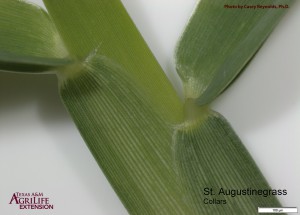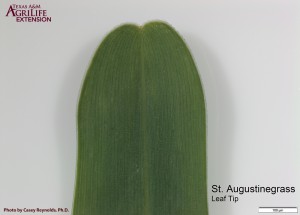Latin Name: Stenotaphrum secundatum (Walt.) Kuntze

Growth Habit: Stoloniferous
Vernation: Folded
Leaf: Flat, smooth on both surfaces, with a blunt tip
Ligule: Fringe of hairs
Auricles: Absent
Inflorescence: Spicate, with spikelets partially embedded in the rachis
Description: St. Augustinegrass is a warm-season turfgrass that spreads laterally by stolons and is one of the most widely planted turfgrass species in Texas, particularly in urban environments. This is due to its superior shade tolerance relative to other warm-season grasses as well as its deep rooting potential and drought tolerance. It also performs well when mowed with a rotary mower at higher mowing heights, relative to other warm-season species, which makes it a popular choice for use in home lawns.
Strengths: Shade tolerance, drought tolerance, deep rooting potential, and rapid establishment.
Weaknesses: Cold tolerance, disease potential, traffic tolerance, and chinch bugs.
Recommended Mowing Height: 2.5 to 3.5 inches
Recommended Mowing Frequency: Weekly using a rotary mower
Fertilization Requirements: 2 to 4 lbs N per 1,000 ft2 per year. Single application rates should range from 0.5 to 1 lb of N per 1,000 ft2 applied during the summer growing season.
| St. Augustinegrass Varieties Available in Texas | ||
| Variety | Latin Name | Availability |
| Amerishade | Stenotaphrum secundatum (Walt.) Kuntze | Sod |
| Captiva | Stenotaphrum secundatum (Walt.) Kuntze | Sod |
| Common | Stenotaphrum secundatum (Walt.) Kuntze | Sod |
| Delmar | Stenotaphrum secundatum (Walt.) Kuntze | Sod |
| Deltashade | Stenotaphrum secundatum (Walt.) Kuntze | Sod |
| Floratam | Stenotaphrum secundatum (Walt.) Kuntze | Sod |
| Mercedes | Stenotaphrum secundatum (Walt.) Kuntze | Sod |
| Palmetto | Stenotaphrum secundatum (Walt.) Kuntze | Sod |
| Raleigh | Stenotaphrum secundatum (Walt.) Kuntze | Sod | TamStar | Stenotaphrum secundatum (Walt.) Kuntze | Sod |



